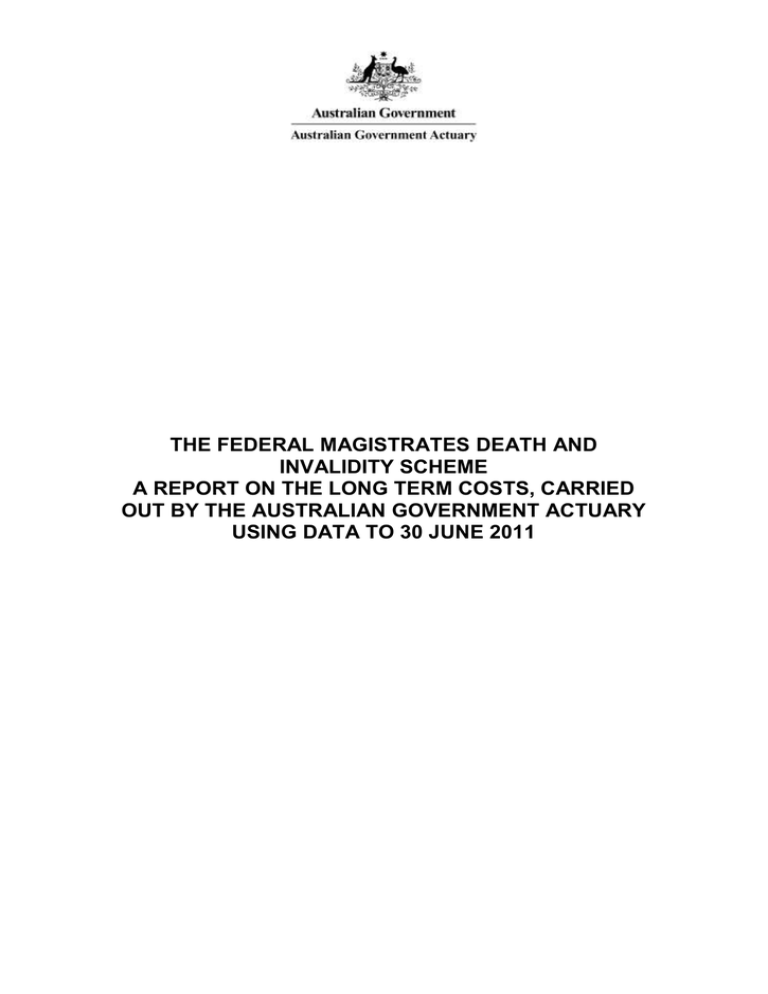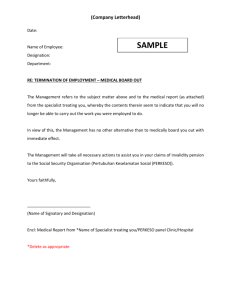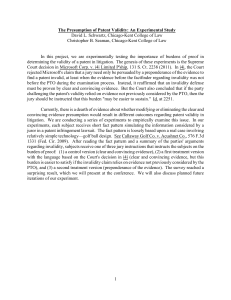THE FEDERAL MAGISTRATES DEATH AND INVALIDITY SCHEME
advertisement

THE FEDERAL MAGISTRATES DEATH AND INVALIDITY SCHEME A REPORT ON THE LONG TERM COSTS, CARRIED OUT BY THE AUSTRALIAN GOVERNMENT ACTUARY USING DATA TO 30 JUNE 2011 TABLE OF CONTENTS 1 SUMMARY .............................................................................................. 3 2 INTRODUCTION ..................................................................................... 4 3 THE FEDERAL MAGISTRATES DEATH AND INVALIDITY SCHEME . 6 4 MEMBERSHIP AND DATA .................................................................... 7 5 ASSUMPTIONS ...................................................................................... 8 6 PROJECTION OF PREMIUM COSTS .................................................. 11 7 PROJECTION OF CASHFLOWS ......................................................... 12 8 ACCRUED LIABILITY .......................................................................... 14 9 SENSITIVITY ANALYSIS ..................................................................... 15 Error! Use the Home tab to apply Report Title to the text that you want to appear here. 1 SUMMARY This report sets out estimates, as at 30 June 2011, of the long term costs arising under the Federal Magistrates Death and Invalidity Scheme, which is governed by the Federal Magistrates Act 1999 (the Act). This is the first report on the long term costs of the Scheme. Experience and Assumptions The Federal Magistrates Death and Invalidity Scheme was established in 2007 and the membership is relatively small. As such, there is insufficient scheme experience on which to base demographic assumptions. The key assumptions used to estimate the costs of the Scheme are those used to value the Judges’ Pension Scheme, as the experience of Federal Magistrates is likely to be somewhat similar to that of members of the Judges’ Pension Scheme. Future premium costs and cash expenditure Projections of premium costs and cash expenditure over the period to 2031-32 have been made. Future premium costs are the estimated future notional insurance premiums required to insure against the expected benefit payments arising from death and invalidity claims in each future projection year. Premium costs are projected to be 2.8% of salaries in 2011-12 and, generally, decreasing slightly over the projection period to be 2.6% in 2031-32. Future cash expenditure is the estimated expected amount of cash payable in each future projection year. Cash expenditure in nominal dollars is projected to increase from $283,000 in 2011-12 to just under $1.1 million in 2031-32. It should be noted, however, that cash expenditures for a small scheme providing only insurance benefits are highly uncertain. Accrued liabilities The direct Commonwealth unfunded liability arising under the Scheme in respect of the current pensioner has been calculated as $1.786 million. 3 Error! Use the Home tab to apply Report Title to the text that you want to appear here. 2 INTRODUCTION 2.1 This report has been prepared within the Office of the Australian Government Actuary at the request of the Department of Finance and Deregulation (Finance). It sets out estimates of the long-term death and invalidity costs arising under the Federal Magistrates Act 1999 (the Act). The Federal Magistrates Act 1999 was altered so as to allow for the provision of lump sum death benefits and invalidity pensions to federal Magistrates with effect from September 2007. For the purposes of this report, we have termed these arrangements the Federal Magistrates Death and Invalidity Scheme (the Scheme). The estimates are based on an examination of scheme data supplied by the Department of Finance and Deregulation and data supplied by the Family Court. 2.2 This is the first long-term valuation of the Federal Magistrates Death and Invalidity Scheme since its inception in 2007. Initial calculations for the AttorneyGeneral’s Department suggested that the cost of the Scheme would be very uncertain, but could be around 6% of salaries. 2.3 2.4 This report provides estimates of the following: • projected future premium costs for each year to 2031-32; • projected future cash expenditure for each year to 2031-32; and • accrued liability. The future premium costs are the estimated future notional insurance premiums required to insure against the expected benefit payments arising from death and invalidity claims in each future projection year. Future cash expenditure is the estimated expected amount of cash payable in each future projection year. As the premium cost includes the capitalised value of all invalidity pension payments (and associated superannuation contributions) arising from an invalidity claim, these premiums will be higher than the cash expenditure in the short term. In the long term, premium costs and cash expenditure would be expected to be of a similar order but with cash expenditure generally higher than premium costs. 2.5 The unfunded liability of the Scheme at inception was zero. Only while an invalidity pension is in payment does a non-zero unfunded liability arise equal to the actuarial value of the pension(s) payable to invalidity claimant(s) (and superannuation contributions). The first claim for an invalidity benefit occurred in the 6 months to 31 December 2009. This claim is still in payment and, as a result, there is an unfunded liability. 2.6 Due to a combination of the relatively small size of the Scheme and the low probabilities of events, the numbers of claims made per year are expected to be 4 Error! Use the Home tab to apply Report Title to the text that you want to appear here. volatile. As a result, actual cashflows may differ significantly from cashflow projections. 2.7 I consider that this report complies with the Institute of Actuaries of Australia Professional Standard 400 (PS400) (Investigations of Defined Benefit Superannuation Funds) allowing for the fact that the Federal Magistrates Death and Invalidity Scheme is unfunded, has an underlying Commonwealth government guarantee and only covers death and invalidity benefits. For reference, PS400 is primarily designed to cover funded (private sector) superannuation schemes where actual contributions paid into the scheme and solvency matters are important. 5 Error! Use the Home tab to apply Report Title to the text that you want to appear here. 3 THE FEDERAL MAGISTRATES DEATH AND INVALIDITY SCHEME 3.1 The legislation covering the Federal Magistrates Death and Invalidity Scheme is the Federal Magistrates Act 1999. It provides for payment of an invalidity pension and a death benefit. The Scheme is an exempt public sector superannuation scheme under the Superannuation Industry (Supervision) Act 1993. 3.2 The Scheme is unfunded and does not hold any assets. The Scheme has no external insurance arrangements. Federal Magistrates do not contribute to the Scheme and the Commonwealth meets all of the costs of benefits. 3.3 Benefits are paid out of Consolidated Revenue as they are due. This is an acceptable method of funding as the Scheme has an underlying Commonwealth Guarantee. 3.4 The main benefits payable from the Scheme are summarised below. • Federal Magistrates who retire due to permanent disability or infirmity are paid a pension until the age of 70 years or until he or she dies (whichever happens first). The annual rate of the pension is 60% of the annual rate of salary the Magistrate would have been entitled to if he or she had not retired. At 1 July 2011, the base salary for a Federal Magistrate was $305,070 and for the Chief Federal Magistrate was $359,520. This means the current pension payable to a retired Federal Magistrate is $183,042 per annum (and $215,712 per annum is payable to a retired Chief Federal Magistrate). Pensioners also receive Commonwealth superannuation contributions of 15.4% of their base salary until the age of 65. • A death benefit is payable where a serving Federal Magistrate dies before age 65 leaving an eligible spouse or children. The benefit consists of a lump sum of the amount of the Commonwealth superannuation contributions that the Magistrate would have been entitled to if the Magistrate had not died, over the period from the Magistrate’s death to age 65. The death benefit is also paid to eligible spouses or children of Federal Magistrates receiving an invalidity pension under the Scheme who die before age 65. 3.5 From 1 July 2011, the Commonwealth superannuation contributions are equivalent to 15.4% of the Magistrate’s annual salary. Prior to this, Commonwealth superannuation contributions were equivalent to 13.1% of the Magistrate’s annual salary. 6 Error! Use the Home tab to apply Report Title to the text that you want to appear here. 4 MEMBERSHIP AND DATA 4.1 We have been supplied with data by the Department of Finance and Deregulation and the Family Court. I am satisfied that the data provided is accurate for the purposes of this report. 4.2 At 1 July 2011 there were 62 serving Federal Magistrates as set out in the table below. SERVING FEDERAL MAGISTRATES at 1 July 2011 Number Total Salaries ($ pa) 4.3 Males 41 12,562,320 Females 21 6,406,470 Total 62 18,968,790 The average age of serving Federal Magistrates at 1 July 2011 was nearly 57 years, with just under 60% being aged between 50 and 60 years. More than onequarter of Federal Magistrates (28%) were more than 60 years old as at 1 July 2011. 4.4 At 1 July 2011 there was one retired Federal Magistrate in receipt of an annual invalidity pension of $183,042. 7 Error! Use the Home tab to apply Report Title to the text that you want to appear here. 5 ASSUMPTIONS 5.1 The Federal Magistrates Death and Invalidity Scheme is a relatively small scheme which, as at the valuation date, had been in operation for less than 4 years. As such, there is little existing experience on which to base demographic assumptions. As a result, we have based the assumptions, for the most part, on those adopted for the Long Term Cost Report on the Judges’ Pension Scheme as at 30 June 2011. We note that most of these assumptions are based on the assumptions used for the most recent Commonwealth Superannuation Scheme (CSS) in the PSS and CSS Long Term Cost Report 2011. 5.2 Details of the assumptions used are provided in Appendix A. Financial Assumptions 5.3 5.4 The significant financial assumptions made in determining the long term cost of the Scheme, are: • the level of future increases in the Federal Magistrates’ salary on which pensions are based; and • the interest rate that is assumed for discounting projected benefit payments to give a present day value. For this report, the following assumptions have been adopted: Interest Rate: 6.0% per annum Long Term General Salary Increases: 4.0% per annum These assumptions represent a 2.0% p.a. real rate of return over the rate of salary increases. These are the same assumptions as those used for other Commonwealth schemes. Note that it is the gap between the two assumptions that will impact most on the estimates of the unfunded liability. Demographic assumptions 5.5 Note that from a benefits perspective there is no difference between age retirement and resignation. Accordingly, I have used the term resignation to refer to any exit from the scheme which does not give rise to a death or invalidity benefit. 5.6 Between 1 September 2007 and 30 June 2011 there were two resignations, one retirement due to invalidity and no deaths. As at 1 September 2007, there were 51 Federal Magistrates, and as at 30 June 2011 there were 62 Federal Magistrates. 5.7 The limited experience available suggests that resignation rates are relatively low for Federal Magistrates. As such, we do not believe it is unreasonable to 8 Error! Use the Home tab to apply Report Title to the text that you want to appear here. assume a low uniform resignation rate for Federal Magistrates aged less than 55 years, and then assume increasing rates of resignation up to age 70. Federal Magistrates aged 70 or more are assumed to retire immediately. 5.8 The costs of the Scheme are sensitive to the invalidity rates assumed. Establishing a realistic set of invalidity assumptions is difficult for a number of reasons. The main reason is that the small numbers of members of the Scheme coupled with invalidity retirement being a low probability exit event results in few exits for analysis. This is evidenced by the fact that there has only been one invalidity retirement from the Scheme since its establishment. The absence of meaningful scheme experience means that we need to rely on external information in setting invalidity assumptions. 5.9 In these circumstances, it would be normal to seek to base the valuation assumptions on those adopted for other comparable schemes with larger memberships and more invalidity exits. Given the similarity of the working conditions of Federal Magistrates and the Commonwealth judiciary, it would make sense to base the Federal Magistrates assumptions on those used for the Judges’ Pension Scheme. However, in the Federal Magistrates’ Scheme, the invalidity retirement benefit is higher than the resignation benefit at all ages. In the Judges’ Pension Scheme, there is no difference between the invalidity retirement benefit and the resignation benefit once eligibility for the retirement pension benefit is attained. Commonwealth judges are eligible to receive a full pension on, or after, age 60 with a minimum of 10 years’ service. Hence, some “standard age” retirements from the Judges’ Pension Scheme after age 60 may be “de facto” invalidity retirements as there is nothing to be gained by these judges applying for invalidity retirement. 5.10 The invalidity element of the benefit design for the Scheme where the invalidity retirement benefit is higher than the resignation benefit at all ages is somewhat unusual. This increases the risk that simply adopting a set of invalidity retirement rate assumptions used for a different scheme might result in an underestimate of the Scheme’s cost. Nonetheless, we have decided, on balance, to assume that the rates of invalidity retirements from the Scheme will be the same as those adopted for the Judges’ Pension Scheme as at 30 June 2011. 5.11 In the light of the sensitivity of the costs of the Scheme to the invalidity rates assumed and the inherent uncertainty about the rates themselves, particularly those for older ages, we have illustrated the sensitivity of the cost estimates to the assumed invalidity rates in section 9. 5.12 There were no deaths among serving Federal Magistrates or invalid pensioners between 1 September 2007 and 30 June 2011. Given this lack of data, the mortality rates of serving Federal Magistrates and invalid pensioners are assumed to be the same as those adopted for serving Judges and invalid 9 Error! Use the Home tab to apply Report Title to the text that you want to appear here. pensioners for the 2011 Long Term Cost Report on the Judges’ Pension Scheme respectively. 5.13 We assume that all Magistrates who die, resign, or retire on invalidity grounds are replaced by new entrants in to the Scheme. Using the observed ages at entry of all Federal Magistrates from June 2000 to April 2011, we have made assumptions on the new entrant age distribution from ages 35 to 69. Detailed assumptions are set out in Appendix A. 5.14 We have assumed the same proportions married as were adopted for the long term cost report on the Judges’ Pension Scheme as at 30 June 2011. 10 Error! Use the Home tab to apply Report Title to the text that you want to appear here. 6 PROJECTION OF PREMIUM COSTS 6.1 The premium cost of the Scheme represents the estimated present value of the cost of all future payments arising from deaths and invalidity retirements which will be expected during each projection year. That is, it is the amount which, if invested, would, together with assumed interest, be expected to be sufficient to meet the cost of all payments in respect of the claims for that projection year. The premium costs are also represented as a percentage of annual salaries for each year. It should be noted that the dollar costs given are in nominal dollars and have not been adjusted to 2011 dollars. 6.2 Based on the data supplied and on the assumptions made, we have calculated the premium costs, as at 30 June 2011, to be around $534,000 in 2011-12, which equates to 2.8% of total salaries. The Table below shows the estimated premium costs for each of the next twenty years. Premium costs are estimated to decrease to around 2.5% of salaries over the projection period. Variations as a percentage of salaries are due to the projected changes to the age structure of the membership over time and thus depend upon the demographic assumptions made, particularly those regarding the age distribution of new entrants. Year Premium cost ($000s) Premium cost (as % of total salaries) 2011-12 534 2.8 2012-13 547 2.8 2013-14 563 2.7 2014-15 582 2.7 2015-16 608 2.7 2016-17 653 2.8 2017-18 679 2.8 2018-19 680 2.7 2019-20 683 2.6 2020-21 688 2.6 2021-22 711 2.5 2022-23 736 2.5 2023-24 756 2.5 2024-25 769 2.4 2025-26 804 2.5 2026-27 830 2.4 2027-28 870 2.5 2028-29 926 2.5 2029-30 975 2.5 2030-31 1,031 2.6 2031-32 1,089 2.6 11 Error! Use the Home tab to apply Report Title to the text that you want to appear here. 7 PROJECTION OF CASHFLOWS 7.1 As well as estimating the premium costs, we have estimated the projected cashflows arising under the scheme. As the Scheme is relatively new, the early cashflows under the new Scheme will be low initially, increasing thereafter. Note that the projected payments include the pension payments to the sole invalidity pensioner as at 1 July 2011. 7.2 The Table below shows the estimated cashflows for each of the next twenty years. It should be noted that the dollar costs given are in nominal dollars and have not been adjusted to 2011 dollars. Year Total cashflow ($000s) 2011-2012 283 2012-2013 355 2013-2014 434 2014-2015 516 2015-2016 569 2016-2017 584 2017-2018 680 2018-2019 777 2019-2020 869 2020-2021 931 2021-2022 744 2022-2023 796 2023-2024 888 2024-2025 896 2025-2026 957 2026-2027 1,002 2027-2028 979 2028-2029 996 2029-2030 992 2030-2031 963 2031-2032 1,078 12 Error! Use the Home tab to apply Report Title to the text that you want to appear here. 7.3 There is some volatility in cashflows from year to year. This is due to the age structure of the current member population. Due to the small size of the population and clusters of members around particular ages, there will be years where the cashflow decreases compared to the previous year. For example, when a member in receipt of an invalid pension turns 65, the superannuation contributions component of their invalidity benefit ceases. If several members turn 65 in a particular year, this may have the overall effect of reducing expected cashflow costs in that year. This effect is magnified at age 70 when the invalidity pension ceases. 7.4 It is important to note that the cashflows given above are based on averages. In practice, cashflows will depend on the incidences of claims and the details of each claim and could vary significantly from those above. For example, a death claim could lead to a “one off” claim in the range of $0 to $1.4 million depending on the age of the individual concerned. We are aware that a serving Federal Magistrate has died since 30 June 2011 leading to a significant benefit payment. 7.5 Cash expenditure initially lags behind premium costs as shown in Section 6. This is because premium costs include the capitalised value of all invalidity pension payments (and associated superannuation contributions) arising from an invalidity claim. Cash payments arising from an invalidity claim are spread over a number of years and will initially lag behind premium costs. In the longer term, the two would be expected to be of the same order but with cash expenditure generally higher than premium costs. 13 Error! Use the Home tab to apply Report Title to the text that you want to appear here. 8 ACCRUED LIABILITY 8.1 Based on the data supplied and on the assumptions made, we have calculated the accrued death and invalidity liabilities as at 30 June 2011 to be $1.786 million. This is the present value of the future invalidity pension payments (and associated superannuation contributions) payable in respect of the one pensioner of the Scheme as at 30 June 2011. As the Scheme holds no assets, the accrued liability is equal to the unfunded liability. 14 Error! Use the Home tab to apply Report Title to the text that you want to appear here. 9 SENSITIVITY ANALYSIS 9.1 As discussed in Section 5, the costs of the Scheme are sensitive to the invalidity rates assumed. The uncertainty around the underlying rates is greatest for the older ages. 9.2 To provide some guide to the possible cost implications of this uncertainty, we have estimated the projected costs assuming higher invalidity rates for serving members aged 60 and older. The assumed invalidity rates for males and females are outlined in the table below. For serving members aged 60 years, invalidity rates are 1.3 times higher than those under the base assumptions, increasing to 5 times higher for serving members aged 69 years. INVALIDITY RATE ASSUMPTIONS Females Age 9.3 Males Base Alternative invalidity Base Alternative invalidity assumptions assumptions assumptions assumptions 60 0.00646 0.00840 0.00601 0.00781 61 0.00679 0.01086 0.00631 0.01010 62 0.00711 0.01422 0.00664 0.01328 63 0.00757 0.01893 0.00682 0.01705 64 0.00804 0.02412 0.00693 0.02079 65 0.00851 0.03404 0.00704 0.02816 66 0.00898 0.04490 0.00715 0.03575 67 0.00944 0.04720 0.00726 0.03630 68 0.00991 0.04955 0.00737 0.03685 69 0.01038 0.05190 0.00748 0.03740 Under these alternative invalidity rate assumptions, approximately 30% of exits from the Scheme would be due to invalidity retirements, compared with around 10% under the base invalidity assumptions. 15 Error! Use the Home tab to apply Report Title to the text that you want to appear here. 9.4 The sensitivity of the premium and cash costs to a change in the assumed invalidity rates are outlined in the table below: PROJECTED COSTS FOR SERVING MEMBERS AS AT 30 JUNE 2011 Premium costs Premiums Cash costs ($000s) (as % of salaries) ($000s) Base Alternative Base Alternative Base Alternative assumptions invalidity assumptions invalidity assumptions invalidity assumptions assumptions assumptions 2011-12 534 772 2.8 4.1 54 85 2012-13 547 786 2.8 4.0 118 217 2013-14 563 789 2.7 3.8 189 362 2014-15 582 815 2.7 3.8 264 502 2015-16 608 867 2.7 3.9 312 510 2020-21 688 1,175 2.6 4.4 694 1,121 2025-26 804 1,357 2.5 4.1 957 1,629 2030-31 1,031 1,601 2.6 4.0 963 1,466 9.5 Under the alternative invalidity assumptions, annual premium costs increase by between approximately 40% and 70% over the next 20 years. These premium costs equate to just over 4% of salaries, an increase from just under 3% of salaries under the base assumptions. As expected, cash costs of the Scheme also increase (in nominal dollars) under these alternative invalidity assumptions. 9.6 It should be noted that the actual costs of the Scheme will depend on actual experience which will only be known with the benefit of hindsight. It is possible that actual costs will be outside the range outlined above. Michael Burt FIAA Actuary Australian Government Actuary 17 December 2012 16 Error! Use the Home tab to apply Report Title to the text that you want to appear here. APPENDIX A DETAILED ACTUARIAL ASSUMPTIONS Financial Assumptions The long term financial assumptions adopted were as follows: Interest Rate 6.0% per annum General Salary Increases 4.0% per annum Pension Increases 4.0% per annum Resignation/Retirement Rates The rates set out in the table below are the resignation/retirement rates applying to serving members. All Federal Magistrates must retire at age 70 years. Attained Age Retirement Rate 59 and younger 0.005 60 0.010 61 0.015 62 0.020 63 0.025 64 0.030 65 0.050 66 0.075 67 0.100 68 0.150 69 0.200 70 1.000 Mortality and Invalidity Retirement The table below illustrates the decrement rates used for deaths and invalidity retirements. The figures represent the number of deaths and invalidity retirements expected per 100,000 contributors at each age. 17 Error! Use the Home tab to apply Report Title to the text that you want to appear here. Deaths Invalid Retirements Age Males Females Males Females 35 38 20 57 61 40 47 26 79 103 45 63 41 127 164 50 88 62 194 255 55 124 106 305 426 60 183 173 601 646 65 274 269 704 851 Pensioner Mortality The table below shows the mortality rates assumed for invalidity pensioners. Age Males Females 40 0.00121 0.00097 50 0.00221 0.00220 55 0.00354 0.00377 60 0.00637 0.00617 61 0.00725 0.00677 62 0.00825 0.00745 63 0.00932 0.00825 64 0.01053 0.00915 65 0.01190 0.01018 66 0.01340 0.01135 67 0.01509 0.01270 68 0.01678 0.01401 69 0.01861 0.01549 18 Error! Use the Home tab to apply Report Title to the text that you want to appear here. Proportion Married The Table below shows the proportions married assumed. Male Female Age Proportion Married Proportion Married 40 0.950 0.950 50 0.950 0.950 55 0.950 0.950 60 0.950 0.950 65 0.950 0.950 69 0.950 0.901 New entrant assumptions The following table below shows assumed age distribution per 10,000 new entrants. Age at entry New entrants (per 10,000) 35 12 36 24 37 104 38 112 39 137 40 175 41 223 42 277 43 334 44 391 45 445 46 495 47 537 48 572 49 597 50 611 51 615 52 607 53 589 54 559 19 Error! Use the Home tab to apply Report Title to the text that you want to appear here. Age at entry New entrants (per 10,000) 55 520 56 471 57 415 58 354 59 288 60 222 61 156 62 95 63 42 64 5 65 5 66 3 67 3 68 3 69 2 Total 10,000 Federal Magistrate new entrants are assumed to commence on a salary of $305,070 in 201112 and indexed at 4% per annum. 20



